Five Intriguing Facts About Lions You Must Know
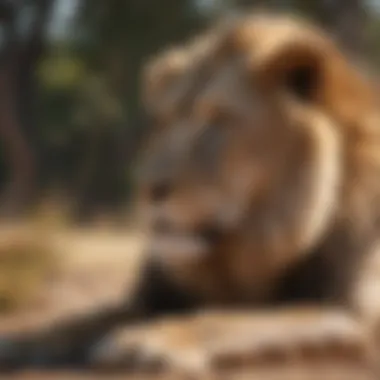
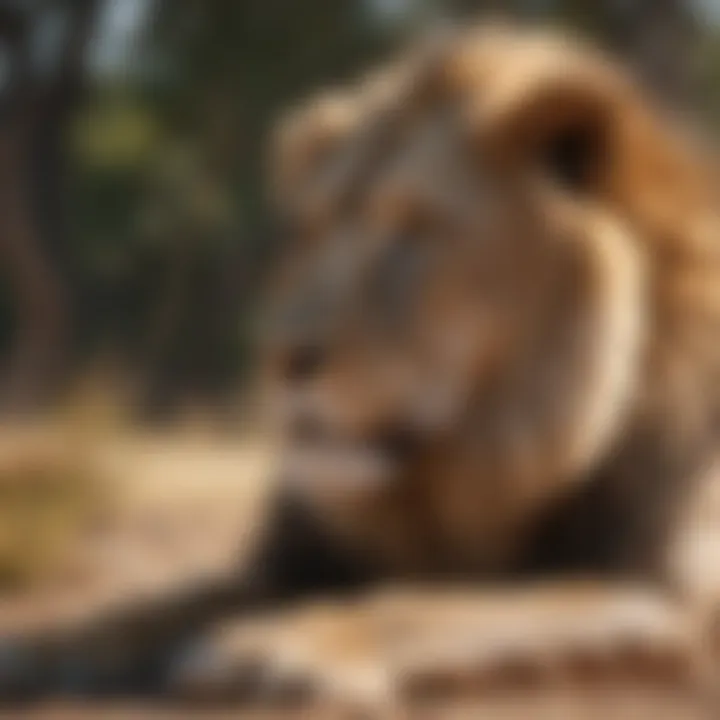
Nature Topic Overview
Fun Facts and Trivia
Here are some fun facts that can amaze young readers about lions:
- Lions are the only cats that live in groups, called prides. A pride can have up to 30 lions.
- Unlike most cats, female lions hunt more than males. They are skilled and work together to catch prey.
- Lions can roar very loudly, reaching up to 114 decibels, which is louder than a jet engine!
- A lion's mane can tell us a lot about its health and age. Darker, fuller manes indicate a stronger lion.
- Lions sleep up to 20 hours a day to conserve energy for hunting.
These fascinating aspects not only attract interest but also encourage readers to learn more.
Wildlife Explorations
Lions share their habitat with other impactful animals. The African savanna is home to various species such as:
- Cheetahs: Known for their speed, cheetahs can reach 60 miles per hour.
- Zebras: Their unique stripes help them blend in with tall grass.
- Elephants: These massive creatures play a key role in shaping the landscape.
In addition to these animals, plants such as acacia trees and grasses are critical for the ecosystem.
Quizzes can be an engaging way for children to learn something extra. Here’s a simple example:
Quiz: Why do you think a lion's roar is important?
A. To scare away hyenas
B. To communicate with pride members
C. To let other animals know where they are
D. All of the above
Answer: D!
Environmental Awareness
Conservation is crucial for lions. Their populations are declining due to habitat loss and poaching. Protecting lions ensures a balanced ecosystem.
Here are some steps children can take to help:
- Spread awareness about lion conservation in your community.
- Reduce waste and recycle to protect wildlife habitats.
- Support organizations that protect lions, like the World Wildlife Fund.
Every small action can contribute to the bigger goal of preserving nature.
DIY Nature Activities
Engaging children in hands-on activities can enhance their learning experience. Here are some suggestions:
- Create a Lion Mask: Use paper plates, markers, and craft supplies. Cut out eye holes and let kids express creativity.
- Nature Scavenger Hunt: Organize a hunt around a park. Create a list of things to find, such as leaves, insects, or flowers.
- Story Time: Encourage kids to write their own story about lions. What adventures do they think these animals have?
Exploring outdoors and getting creative helps solidify understanding of wildlife.
Through these sections, we can see how lions are more than just impressive animals. They play a role that’s essential for our ecosystem. By learning about their behaviors and challenges, young minds can become advocates for wildlife conservation.
The Social Structure of Lions
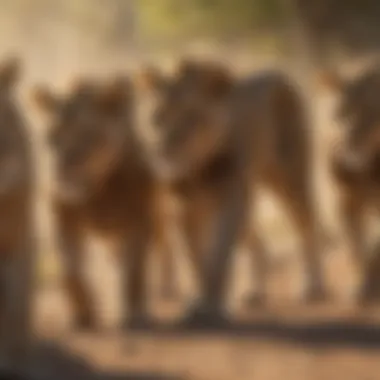
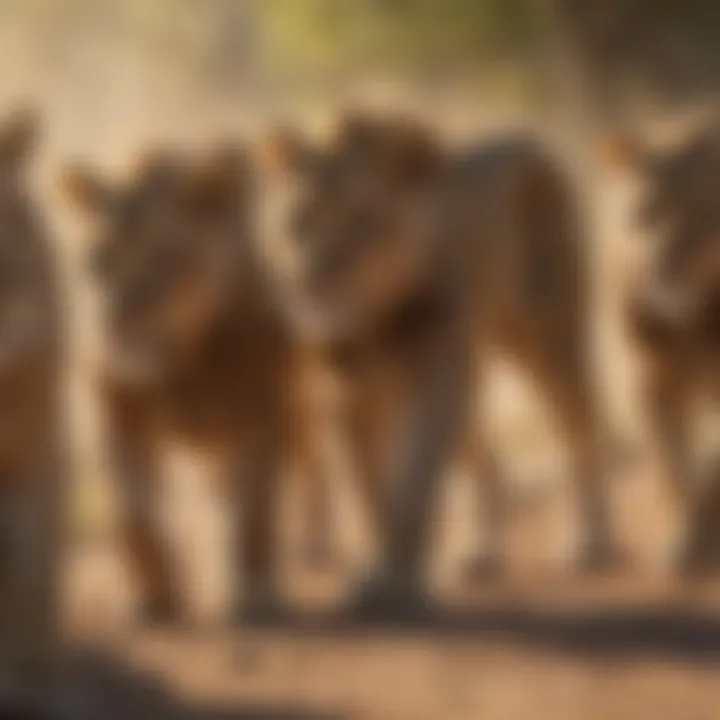
Lions are unique among big cats because of their complex social behavior. Understanding the social structure of lions is key to appreciating how they live and thrive in the wild. Their social interactions and group dynamics play crucial roles in their survival and overall hunting success. This section shares insights into their social system, emphasizing how collaboration improves their quality of life.
The Pride System
A lion pride consists of a few related females, their cubs, and one or a few males. The pride system is vital for cooperative hunting, protecting the young, and maintaining stability within the group. A pride may range from just a few members to more than 30 individuals. These social groups offer advantages like shared resources and enhanced protection from threats.
Understanding the pride's structure helps decode the lions' behavior. It is fascinating to note how these family-like units function effectively in their environment.
Roles Within a Pride
Diverse roles within a pride contribute significantly to its survival and functioning. Each lion, whether male, female, or cub, has distinct duties.
Males
Males typically hold the responsibility of guarding the pride's territory. They establish dominance through strength and vocalizations, ensuring that rival males stay at bay. Their key characteristic is their intimidating presence, often marked by a large mane. This feature not only signifies maturity but also serves to attract females.
The strong males are beneficial for the pride, providing safety. However, they face challenges like competition for territory. Males must balance aggression with protective instincts, which can impact their survival.
Females
Female lions are primarily responsible for hunting and nurturing cubs. Their collaborative hunting efforts enable the pride to secure ample food. This cooperation greatly increases their chance of capturing prey. Females are known for their skillfulness and agility in hunting, often working in groups to bring down animals much larger than themselves.
Their unique contribution to the pride includes caring for the young. However, the burden of hunting can lead to exhaustion, especially when food is scarce. Despite challenges, their strength lies in unity and efficiency.
Cubs
Cubs are essential for the pride's future. Although they do not directly contribute to hunting or territorial defense, they play a vital role in ensuring the pride's legacy. Cubs learn by observing and mimicking adults, developing skills for survival.
A major characteristic of cubs is their playful nature. This behavior strengthens social bonds and helps them learn critical skills in a safe environment. However, they are vulnerable to predators and must depend on adult lions for protection until they mature.
Territorial Behavior
Lions are territorial animals, often establishing specific areas for their pride. Males play a crucial role in marking and defending these territories. Their vocalizations, especially roars, serve to communicate boundaries and deter outsiders. Knowing how lions establish and defend their territories is essential for understanding their social structure. This behavior not only helps them secure food resources but also ensures the safety of their young.
"Lions, in their social structure, highlight the significance of cooperation and competition in the wild."
This exploration into the social structure of lions reveals the intricacies of their behavior. From the pride system to the roles within it, every aspect contributes to their survival and dominance in the animal kingdom.
Predatory Techniques of Lions
Lions are skilled hunters, using various techniques that show their intelligence and teamwork. Understanding these predatory techniques is crucial to appreciate how lions survive in the wild. This section delves into their hunting strategies and the timing of their hunts. Learning about these aspects helps educate young minds on the intricacies of nature and the survival of species.
Cooperative Hunting
One of the most remarkable traits of lions is their ability to hunt together. When hunting, lions form groups called coalitions or prides. This teamwork increases their chances of catching prey. Often, females lead the hunts because they are nimble and better at pursuing the prey. Males also join in, usually to fight off other predators if needed.
Cooperative hunting allows lions to take down larger animals such as wildebeests or zebras. Each lion takes on a role. Some may chase the prey toward other waiting lions. This strategy is quite effective as it allows them to corner their target. The element of surprise is crucial, and lions use stealth to get close before making a move.


Things can go wrong, too. If the prey escapes, the lions may not eat for a long time. This risk makes the hunt a significant event for them. Their strong social bonds during hunts also contribute to the pride's strength. Each successful hunt promotes unity and ensures the survival of the group.
Hunting Times
Day vs. Night
Hunting times vary significantly between day and night. Lions are generally nocturnal hunters, meaning they prefer to hunt under the cover of darkness. This behavior is beneficial. At night, the cool temperatures make it easier to engage in strenuous activities. Moreover, their dark fur blends into the shadows, which allows for stealthier approaches to prey.
During the day, lions may hunt if conditions allow, but they often take to resting in the shade to conserve energy. Thus, the hunting time is a key characteristic of their survival strategy. It adjusts based on the environment, prey availability, and weather patterns. Overall, hunting at night offers lions clear advantages in terms of stealth and energy management.
Seasonal Variations
Seasonal variations also play a role in hunting patterns. In wet seasons, prey animals are more plentiful and mobile. Lions often adjust their hunting techniques to account for these changes.
During dry seasons, food becomes scarce. Lions may hunt more aggressively in those times. They will target weaker animals that cannot escape easily. This adaptability highlights how lions can thrive in varying conditions, maintaining their role as apex predators. This section illustrates that lions are always adjusting their strategies based on their immediate environment, making them fascinating creatures in the animal kingdom.
"The effectiveness of a lion's hunting strategy shows the brilliance of nature's design. Understanding this allows us to appreciate wildlife more deeply."
Vocal Communication Among Lions
Lions use their voices to interact and communicate with each other. Understanding their vocalizations is important for appreciating the complex social lives of lions. Communication among them ensures the pride functions cohesively. Each vocal sound has a specific meaning, helping to strengthen bonds and manage social hierarchies. This aspect of lion behavior is vital for survival and cooperative living in their natural habitat.
Roars and Their Significance
Roaring is perhaps the most recognized sound of lions. A lion's roar can be heard from a distance of up to five miles. This powerful vocalization serves several purposes. Firstly, it marks territory, sending a clear signal to other lions that a specific area is claimed. Secondly, it helps to locate other pride members, especially in dense bush where visibility might be limited. The roar signifies strength and assertiveness, reinforcing the social hierarchy within a pride.
"The roar of a lion can echo through the savanna, a reminder of their majestic presence and dominance in the wild."
Other Vocalizations
While roars play a crucial role, lions also produce a variety of other sounds to communicate. These include growls, grunts, and barks.
Growls
Growling is associated with aggression or warning. It is a low, throaty sound that can indicate that a lion feels threatened or is asserting dominance. This vocalization is crucial in maintaining social order within the pride. When a lion growls, it often signals to others to keep their distance. The power of a growl is in its ability to convey strong feelings without physical confrontation, allowing for the establishment of boundaries.
Grunts
Grunts serve a more subtle purpose. Lions use grunts to communicate with one another during relaxed moments. It is a soft sound that helps maintain connections among pride members during activities like groomin or resting. The gentle nature of a grunt promotes bonding and reassuring presence among lions. This sound enhances group cohesion.
Barks
Barking is less common but still important in lion communication. When lions bark, it can indicate surprise or alertness to potential threats. The barks are often short and sharp, alerting other members of the pride to be on guard. This vocalization can be a lifesaver, as it helps to keep the pride informed about dangers nearby.
Conservation Status of Lions
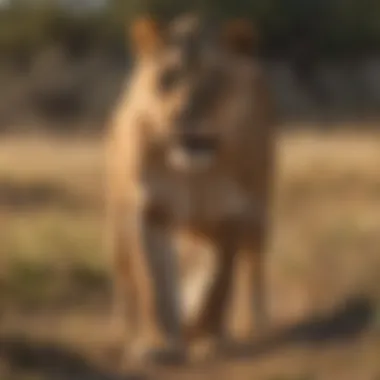
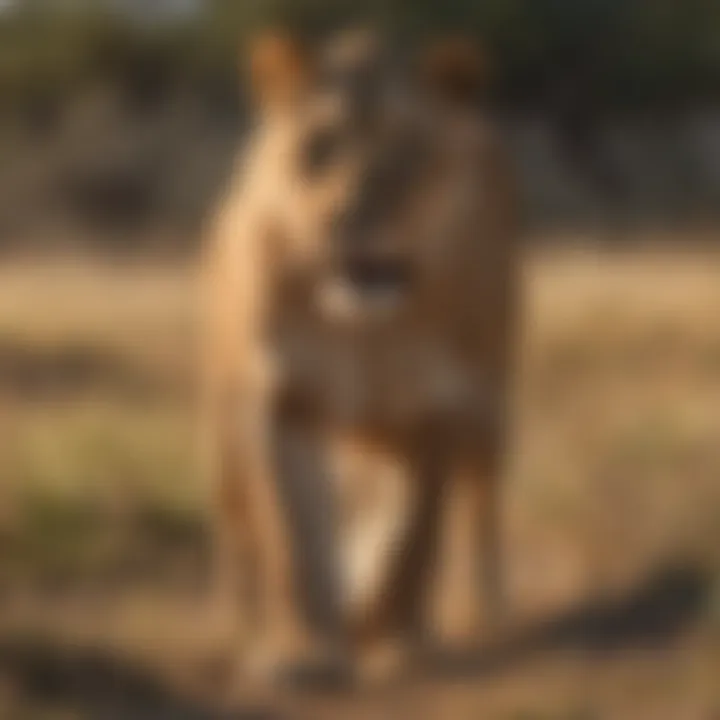
The conservation status of lions is a vital aspect of understanding their survival and the broader implications for the ecosystem. Lions, once abundant across Africa and parts of Asia, now face a range of threats that have significantly reduced their populations. This section discusses the key factors affecting lions today, focusing on how these threats and ongoing conservation efforts influence their future.
Threats to Lion Populations
Habitat Loss
Habitat loss is one of the most pressing issues facing lion populations. As human activities expand, wild spaces are converted into agricultural land, urban areas, and infrastructure projects. This encroachment impacts lions directly, restricting their roaming habits and access to prey. As a result, the genetic diversity of these animals suffers, weakening their overall resilience.
The significant characteristic of habitat loss is that it simultaneously affects multiple species. For lions, smaller territories mean more competition for food, which can lead to increased conflict among pride members. This topic is beneficial for the article as it highlights the interconnectedness of wildlife conservation issues. The unique feature here is that preserving lion habitats also helps other species. By advocating for larger protected areas, we can benefit entire ecosystems.
Poaching
Poaching is another critical threat to lions. While poaching is often associated with the illegal hunting of elephants and rhinos for their tusks and horns, lions also fall victim. Their body parts are sometimes sought after for traditional medicines or as symbols of status. This illegal activity substantially contributes to the decline in lion numbers.
The key aspect of poaching is the direct impact on population figures. When adult males are removed from their prides, it disrupts social structures and increases vulnerability. Addressing poaching through stricter laws and enforcement is essential, making it a relevant point in our article. Moreover, understanding the unique features of poaching can lead to more effective strategies in conservation. However, the disadvantage of focusing purely on poaching is that it diverts attention from habitat preservation, which is equally critical.
Human-Wildlife Conflict
Human-wildlife conflict arises primarily where lion habitats overlap with human settlements. Farmers may perceive lions as a threat to livestock, which can lead to retaliatory killings. This conflict not only endangers lion populations but also intensifies the negative perceptions of wildlife among local communities.
The key characteristic of human-wildlife conflict lies in its socio-economic components. For our audience, this touches on conservation's broader role, which encompasses community engagement and education. Addressing this issue can foster coexistence strategies, showing that lion conservation benefits local communities. One unique aspect is that solutions can include compensation for livestock losses, which incentivizes communities to protect rather than harm lions. The downside, however, is the need for resources and coordination, which can be challenging to implement effectively.
Conservation Efforts
Numerous conservation efforts aim to improve the status of lions in the wild. Organizations like the African Wildlife Foundation and Panthera focus on habitat restoration, anti-poaching initiatives, and educating local communities about the benefits of preserving lion populations.
Initiatives to establish wildlife corridors that allow lions to roam freely between fragmented habitats are gaining traction. Likewise, community-based conservation programs have cropped up, encouraging local people to take an active role in protecting wildlife.
Cultural Significance of Lions
Lions are not just remarkable creatures in the wild; they hold a profound place in various cultures around the globe. Understanding their cultural significance provides insight into how societies view bravery, power, and community. As symbols, lions represent strength, courage, and nobility across many traditions. Many people are drawn to these aspects due to their majestic presence and role as apex predators.
The lion's image can be seen in emblems, flags, and art, reflecting characteristics that societies admire. Cultures often use lions to convey virtues such as leadership and protection. This importance helps to underline the need for conservation. When people feel connected to lions through culture, they are more likely to support efforts to protect these animals and their habitats.
Symbolism in Various Cultures
In different parts of the world, lions are associated with specific traits and stories. For example, in ancient Egypt, the lion was seen as a protector, symbolizing power and royalty. The goddess Sekhmet was depicted as a lioness, embodying ferocity and protective instincts. In contrast, in many African cultures, the lion is a symbol of bravery. Traditional stories often highlight lions as the kings of the animal kingdom, demonstrating the strength needed to lead.
In Asia, particularly in China, lions appear in festivals and sculptures as symbols of protection and good fortune. Chinese guardian lions are thought to ward off evil spirits.
Key Symbolic Traits of Lions in Cultures
- Strength and Bravery: A common theme in many folklore stories.
- Royalty and Leadership: Often depicted as symbols of kingship, particularly in royal coats of arms.
- Protection: Associated with safeguarding communities from harm.
Representation in Literature and Media
Lions have played significant roles in literature and media, further solidifying their cultural impact. From ancient fables to modern films, lions often emerge as powerful characters that demonstrate the struggle between good and evil. C.S. Lewis's character Aslan in "The Chronicles of Narnia" serves as a prime example. Aslan represents nobility and sacrifice, qualities often personified by lions in various narratives.
Moreover, animated movies like "The Lion King" introduce younger audiences to the world of lions. These stories portray themes of family, responsibility, and the circle of life. They educate children about nature and inspire a sense of respect for wildlife.
Notable Representations of Lions
- Aslan in "The Chronicles of Narnia": Symbolizing messianic sacrifice.
- Simba in "The Lion King": Embodying growth, resilience, and leadership.







